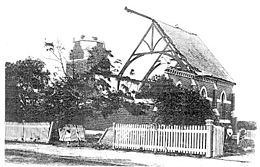| F3 tornado | |
|---|---|
 The Methodist Church, Hawthorn Road, completely destroyed by the tornado The Methodist Church, Hawthorn Road, completely destroyed by the tornado | |
| Formed | 2 February 1918 5:45 pm |
| Duration | 30 minutes |
| Dissipated | 2 February 1918 6:15 pm |
| Highest winds |
|
| Max. rating | F3 tornado |
| Fatalities | 2 fatalities |
| Damage | A£100,000–150,000 |
| Areas affected | Brighton, Victoria |
| Most severe tornado damage; see Fujita scale | |
The Brighton tornado is the strongest storm recorded in Melbourne to date.
On the afternoon of 2 February 1918, with prevailing north-westerly winds and a heat wave (typical conditions for Melbourne thunderstorms). After a severe storm formed and moved off Port Phillip, two tornadoes struck Brighton beach simultaneously at approximately 5:45 pm and proceeded inland, converging near the junction of Halifax and Church Streets. Five minutes later, a third tornado struck. The tornadoes then tracked east over open fields.
Damage retrospectively rated F3 on the Fujita scale was observed in places. Two people were killed, a man and a boy, while the drowning of a woman at St Kilda beach is believed to be related to the same storm cell. Over 6 were injured in the Brighton area.
The tornado completely destroyed the Hawthorn Road Methodist church, which was later rebuilt. Numerous homes were demolished. The tornado badly damaged the Brighton Baths, tore the roof off Royal Terminus Hotel and destroyed the verandah of Grimley's Hotel. Extensive damage was incurred to infrastructure on the Sandringham railway line. Several community and sporting facilities were destroyed including the cricket club grandstand and a bandstand. It also damaged the burial monument of Adam Lindsay Gordon in the Brighton general cemetery.
See also
References
- ^ pg 4 Zeehan and Dundas Herald Thursday 7 February 1918
- "The Brighton Cyclone 2nd February 1918". Brighton Historical Society Inc. Archived from the original on 9 August 2008. Retrieved 2008-04-05.
- "Brighton Cyclone(Tornadoes)". Geoscience Australia. Retrieved 5 April 2008.
- ^ pg 3. Brighton Southern Cross 5 October 1918
This article about a place in Melbourne is a stub. You can help Misplaced Pages by expanding it. |
This article about or related to natural disasters is a stub. You can help Misplaced Pages by expanding it. |